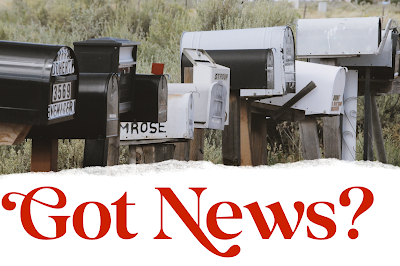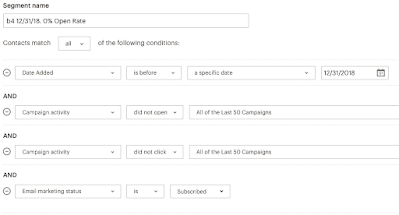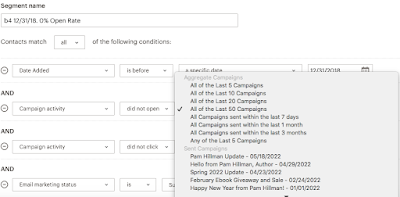by Pam Hillman
Let’s talk about newsletters. Specifically, newsletter subscribers.
And… as usual, at the last minute, I figured out how to find the 0% Open and 0% Click throughs, so this post, as well as my time spent whittling my list down, could have been a LOT shorter. But a hard lesson learned is one well learned. So if you're strapped for time, just scroll to the bottom.
We've all heard the following mantras: “More than anything else, grow your newsletter list”. Or “Your newsletter subscribers are GOLDEN”. “You have control of the email addresses entrusted to you by your fans, not Facebook, Twitter, etc.”
You get the drift. All of that is true and we jump through hoops to be part of promotions and giveaways to grow our mailing list. Nothing wrong with that.
And newsletter services took note. As your subscriber base grows, you’ll have to pay for an account. Nothing wrong with that, either. But what isn’t said most of the time is that it’s just as important (more so!) to manage your subscribers after you get them as it is/was to get them in the first place.
First, there is a ton of information online about what to do and not do with newsletters, how to manage subscribers, and which service providers are best for you. But that’s the problem. There is SO much information that I could never figure out what I needed to know and what I didn’t. So it was easier to just keep building my list. 500 subscribers. 2k. 3k. Wow! How exciting!
Not exactly.
A few years ago, I had to go to a paid plan, and it’s been costing me about $500 a year. So this month I finally took the time to really dig into my newsletter service and the fees I've been paying. I’m not sure I’m providing any new information for your toolbox, but it was new to me, so here goes…
I wish someone had told me in simple language how important it is to review my lists on a regular basis, because if I had, without a doubt, I wouldn’t have had to upgrade to a paid service plan during the last 3-4 years. You do the math. 4 years x $500. Gulp.
So, it is a good idea to figure out how your service (Mailchimp, Mailerlite, Constant Contact, etc.) works and manage it effectively… before you get to the stage that you’re forced to pay handsomely for the service.
I have Mailchimp, so most of what I’m going to talk about is specific to that service provider, but (in general), it should apply to whatever service you’re using, depending on how many subscribers and email sends you’re allowed.
And, yes, I could switch from Mailchimp to a different provider, and I may at some point. But the bigger and more urgent problem was that I had a lot of contacts on my list who weren't engaged and were costing me money.
Things I wish I’d paid attention to for the last 10+ years:
- Subscribed
- Unsubscribed
- Cleaned Email Addresses
- Archived Email Addresses
While Subscribed, Unsubscribed, and Cleaned sounds self-explanatory, from what I’ve gathered, it is not. Or at least the gazillion posts I waded through made it seem that way. As best as I could tell, Subscribed AND Unsubscribed count toward your billing on Mailchimp with their current plans. Which makes no sense at all. Unsubscribed is unsubscribed, but whatever.
I could be wrong, though, since I was on a “Legacy” plan up until I started this “clean-up” journey. But I don’t think Mailchimp was charging me for the 870 unsubscribed emails on my list. Also, cleaned email addresses are those that pretty much are going into a dark hole, so according to Mailchimp, you shouldn’t be charged for those, but you can’t archive them either. As one article said, they’re just “dead in the water”.
Regardless, since I didn't want to see those 870 unsubscribes on my list, I archived them as Mailchimp was very clear that no matter what plan you were on, you would not be billed for ARCHIVED email addresses.
Now let’s talk about the following…
- Ratings
- Segments
- Tags
- Open Rate
- Click Rate
Mailchimp gives each subscriber a Rating of 1-5, and it’s not very accurate, imo. But at least it’s a starting point.
Mailchimp makes it easy to Segment your lists in all sorts of ways, and Ratings is one of them. According to one of those “know everything” articles, if you’re going to archive a group of contacts, the #2 group is the one to archive.
Think of Ratings, Segments, and Tags as a big picture, little picture scenario, or using Segments and Tags to “drill down” on your subscribers. I’m currently using it to whittle down my inactive subscribers, but it’s a good way to BUILD UP your list as well. Hopefully, we'll talk about that in a later blog post in a month or two.
I segmented my lists this way for now:
#1 Rating - According to Mailchimp, these recipients have either unsubscribed and resubscribed, or soft bounced in the past.
#2 Rating - These rarely engage, but all new subscribers start out as #2 rating, so you can't just willy-nilly archive all of the #2 ratings.
#3-#5 Rating - These are supposed to be the most engaged. Later, I will segment these out in order to send targeted campaigns to my most engaged subscribers.
I’m in the process of going through 800 subscribers who have a #2 rating but signed up at least 2 years ago and as far back as 2011. These subscribers rarely engage according to MC. But #2 is weird, because some of these people have a 15-30% open rate, so that’s why I’m manually going through these. Granted, click rate is much more important than open rate, and I’ll talk about that a bit more below.
Where do Tags come in? You can do ANYTHING you want with tags. I had over 700 in my segment of #2 rating of subscribers who’d been with me 2 years or longer, but hadn’t opened anything in a long time, if ever. I needed a way to manage that group in small chunks as I only needed to reduce my subscriber base a couple hundred to downgrade to the free account.
Now, here's where I wasted some time over the last few weeks. At night, while sitting around watching tv with hubby, I’d pull up the #2 rating segment, tag a group of 50 with a temporary tag of SMALL GROUP, then I’d manually check that group to see what their open/click rate was. Sometimes I’d even look at their history a bit. Once I decided to archive them, I added an ARCHIVE tag and removed the SMALL GROUP tag and they would immediately disappear from my “small group of 50” that I was working on. Every few hours or every couple of days, I’d look at the group I’d decided to archive (tagged appropriately as ARCHIVE), choose them all, and actually archive them. Clear as mud, yes? lol
Oh, and while I was at it, I added tags like “Do Not Archive”, “5%+ Click Rate” to those I was keeping. I’m nowhere near done, but I met my goal of whittling down below 2000. From now on, I’ll only archive subscribers that have a 0% Open Rate AND a 0% Click Rate and have been on my list for years.
Here’s an important tip: If your list isn’t out of control like mine was, start learning how to manage it now. On the other hand, if you have THOUSANDS of (as in 20, 30, 80 THOUSAND) subscribers, I can’t help you! But maybe YOU can help the rest of us! Do tell your secrets for such a robust list. lol
Final Takeaways:
- DO learn how your provider works.
- DO learn about segments and tags.
- Don’t just blindly archive based on Mailchimp’s ratings. Many of my 2 star ratings have a 30-40% open rate.
- DO review your list regularly. If you only have a few hundred subscribers, the time to start is now. If you don’t want (or need) to archive anyone yet, at least segment them so that you can manage them better when the time comes.
- Do I WANT to be below 2000 subscribers just so I can have the free plan? No. But if 500-1000 subscribers haven’t opened or clicked anything in 3 or 4 years — if EVER — then there's no need to pay to send them an email that they aren't going to look at. At least for now.
- Are these archived subscribers gone forever? Again… no. As I learn more about how to improve my open and click rates, I can test drive some of these guys. Maybe even unarchive in small groups and alert them to a new release and see how they respond.
Final, Final Takeaway
As I was finishing this up, I went back into my Mailchimp account and searched one last time for 0% open rate and 0% click rate and I found it. Sigh. The thing is, there are many different ways to search for your subscribers and determine if they haven’t been engaged at all, ever. I hated archiving ANY of mine, but it had to be done.
Here's an example of a segment with 3 parameters. It's before 12/31/2018, a 0% Open Rate, and 0% Click Rate, AND has not opened any of the last 50 Campaigns. Contact can match "Any" or "All" of the conditions you assign.







Wow! Thank you for taking the time to share all this knowledge and research. Mailchimp is the one I'm most familiar with so this was super helpful. Thanks, Pam!
ReplyDeleteGlad it was helpful. Seems like I just spewed out a bunch of words! lol
DeleteWow! Sounds overwhelming.
ReplyDeleteI think my rush of words mad it more so than it really is. :) I think many authors (and anyone who needs a newsletter) is pushed to gain more and more subscribers without knowledge of how to care for their precious subscribers effectively.
DeletePam, thanks for the info.
ReplyDeleteYou're welcome!
ReplyDeleteThis is great information, Pam, and a lot that I hadn't thought of before.
ReplyDeleteMy subscriber list is well below the limit to start paying for a plan with MailChimp, but I recently switched from MailChimp to Mailerlite (I found it easier to work with to put out a nicer looking newsletter.) It sounds like THIS is the time for me to start analyzing my subscribers.
(Something more to work on - who said this writing business was about writing books? Uff da!)
But then there's the other side of the coin - being disciplined about putting out a regular newsletter. I've been so bad about that, and I'm sure that affects my open rate and click rate.
How often is "just right" for a newsletter? I'm leaning toward once a month, or every other month, with a special mailing for new releases. Do you have any thoughts?
Jan, I've been reading up on this question ... how much is too much vs. how much is too little ... and I've got an ebook that addresses this, Newsletter Ninja. I'm hoping to do a deep dive into that next month.
DeleteI personally don't like receiving newsletters all the time, but I read somewhere that I'm not my reader, and some readers DO enjoy news from their favorite authors and/or other favorite hobbies often. I can't remember if that tip was in that ebook or somewhere else, but I think it's worth a shot. Especially if we're on point with content and figure out what our subscribers click on the most. I'm starting to look at my analytics more to see what makes my subs engage the most.
And I have a question for you. Since you switched from Mailchimp to Mailerlite, would you say that the process of creating a newsletter is faster or slower through Mailerlite? It takes me forever to create a newsletter through Mailchimp, but that might be more my slow internet over the actual service itself.
There was a bit of a learning curve when I switched, but not too much. For me, Mailerlite is more user-friendly. For me, it's much easier and faster to put a newsletter together and I like the results more. The end result is more professional looking, IMHO.
DeleteYou could always try the free version and see how you like it!
Thanks Jan! I might have to check out Mailerlite. I like Mailchimp fine but it does seem like it takes a long time for things to load on the program.
DeleteVery interesting, Pam. I certainly don't need this information now, but someday maybe.
ReplyDeleteDefinitely keep it in mind when you start building a list.
DeleteI love it when you deep dive on a topic. :) It means I don't have to! Thank you for sorting this out and shedding some light on a mystifying typic. Now to get my VA on the subscriber trail!
ReplyDeleteHope your VA still loves you and ME after that! lol
DeleteHa! Glad to take one for the team. :)
ReplyDeleteGreat blog post, Pam!
ReplyDeleteThis comment has been removed by a blog administrator.
DeleteThanks for posting Pam! This is an excellent reminder to sort through mailing lists. I heard another multi-published author say she'd whittled down her list to a couple of hundred subscribers in a similar fashion, because she'd rather have contact with those readers who were her true readership, rather than people who weren't interested in her books but had signed up because of a promotion, etc. Her readership would be the people to buy her next book or recommend it to others.
ReplyDeleteWow, she was a lot braver than I am! :) But, yes, she makes an excellent point. We want to share an engaging newsletter and BOOKS with engaged readers. It's pretty simple.
DeleteThanks for the post. I have whittled my audience in the past, but will probably need to do so again soon and this article reminded me that I need to pay more attention to tags and segments. Thanks!
ReplyDeleteIt's an ongoing process, isn't it? Go forth and conquer!!
Delete